Every spring and summer, Chinook salmon gather in vast schools along the central coast of California, fattening up on krill and small fish before their autumn spawning migration into the Central Valley. Fishermen in commercial boats, private skiffs and kayaks take to the water, and most summers, the fleet catches several hundred thousand Chinook weighing somewhere between five and 30 pounds. Many more are caught by fishermen in the Sacramento River and its tributaries.
California’s bounty of salmon, however, does not reflect a thriving fish population. Rather, many, if not most, of California’s salmon are born in five Central Valley hatcheries and released into the wild as juveniles. Without these facilities — including one just below Folsom Lake — there would be almost no salmon at all in some years. That’s because upriver dams and powerful irrigation pumps in the Sacramento-San Joaquin Delta have made the valley’s rivers nearly incapable of supporting natural spawning runs. And while thousands of adult fish lay and fertilize eggs in the gravel beds of the Sacramento River and its tributaries each year, most offspring die before reaching the ocean.
By removing or altering many of the natural selection mechanisms by which Chinook salmon evolved to thrive in California’s arid climate, fish hatcheries are creating a genetically inferior fish.
But the hatchery life-support system the salmon fishery depends on is fraught with problems and is causing unintended side effects that may be doing more harm than good. While the facilities have masked a precipitous decline in naturally spawning salmon populations, hatcheries are also doing something else: By removing or altering many of the natural selection mechanisms by which Chinook salmon evolved to thrive in California’s arid climate, they are creating a genetically inferior fish. When spawning time comes, many hatchery-born salmon pair up with salmon of increasingly threatened natural lineage and, in doing so, pass on their genetic deficiencies.
Peter Moyle, a UC Davis fisheries biologist, says the Central Valley’s Chinook salmon are becoming more poorly suited for survival with each generation. Most hatchery-born juveniles, he says, die shortly after they are released into the wild, a result of generations of artificial selection in captivity.
“[It’s] because of the way they are reared, in uniform cement troughs, feeding on pelleted food,” he says.
The crux of the problem, Moyle says, is that, over generations, hatchery salmon become very well adapted to survival in a man-made environment free of predators and very poorly adapted to living in the wild — hallmarks of a domesticated animal.
In some ways, hatcheries may actually be reversing the work of natural selection and evolution. Moyle says hatcheries have in the past inadvertently selected for more docile fish. They’re easier to handle in the processing rooms, where the fish are cut open and their eggs and sperm are combined in trays. However, docile animals are probably not the first that would have been favored by natural selection in an environment of rapids, competing male spawners and predators on the river bank.
At the Nimbus Fish Hatchery in Gold River, between 5,000 and
9,000 eggs are removed from each female salmon, artificially
fertilized and then reintroduced to the river to improve their
odds of survival.
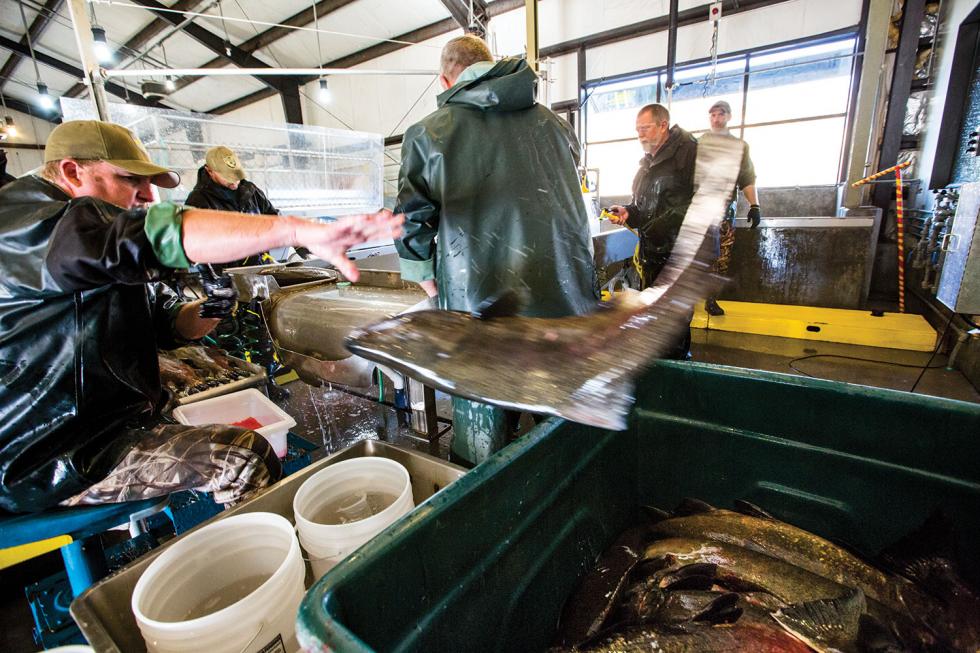
Also, in the rearing tanks where the young salmon live for several months, some small fish tend to hold nearer to the bottom, while others keep closer to the surface — behavioral traits, scientists say, that are determined by genes. The fish that hover just under the surface, where dried food pellets are scattered at regular intervals, receive the most nutrition with the least effort, and they grow stronger, faster. The other fish may fail to survive at all.
But when the day comes for hatchery staff to release the baby salmon into the wild, the fish that linger near the surface no longer find showers of easy food raining down at regular intervals. Rather, they are now easy targets for predatory birds.
“Nature would have selected, from the day they were born, the smolts that keep near the bottom,” says Jacob Katz, director of salmonid restoration initiatives with the group California Trout.
While some hatcheries now run genetic analyses of the fish prior to spawning them to avoid causing inbreeding — a commendable advancement — matching males to females may be trickier than it seems. Carson Jeffres, a researcher with the UC Davis Center for Watershed Sciences, says observations of wild spawning activity reveals a complex set of criteria that a female salmon uses to select the most optimal mate. “But we haven’t identified what it is [that makes a fish choose its mate],” says Jeffres.
One of the most discussed side effects of hatcheries is their role in the long-term loss of genetic diversity observed in Central Valley Chinook. Over the past few decades, the Central Valley’s genetically distinct,river-specific salmon populations have become blended into a single homogenized strain, consisting of individuals that are more and more like clones of one another with every passing year.
At the Nimbus Fish Hatchery in Gold River, between 5,000 and 9,000 eggs are removed from each female salmon, artificially fertilized and then reintroduced to the river to improve their odds of survival.
This is partly because of a system of trucking hatchery smolts downstream for release directly into the bay. Though such assisted transport increases the smolts’ odds of survival, it also means the little fish, when they become adults, are unable to smell their way back upstream to their birth rivers. Instead, they do what scientists call straying, and spawn at random in any of the many Sacramento River tributaries.
“You have fish straying everywhere, and often those hatchery fish overwhelm the natural spawners,” Moyle says.
A peer-reviewed study published earlier this year in San Francisco Estuary and Watershed Science identified multiple ways in which hatcheries have reduced the genetic variability of the fall-run Chinook. The authors, Stephanie Carlson and Eric Huber, say straying is problematic for conservationists because declines in wild fish numbers may become undetectable if spawning streams are inundated with stray hatchery fish.
But hatcheries, which have changed their practices over the years in response to research, have had positive effects. Aside from allowing a robust fishery to operate along the West Coast, hatcheries may also have kept some races of Chinook from going extinct, according to John McManus, executive director of the Golden Gate Salmon Association, a group that supports salmon habitat restoration.
Salmon Roe are tended to in hatching jars at the nimbus fitch
hatchery.
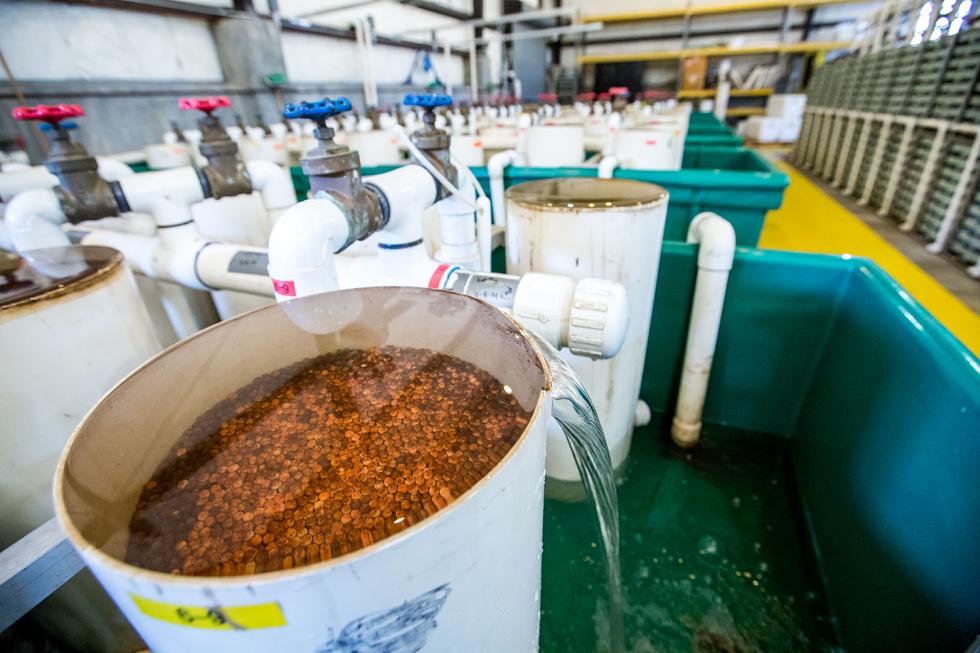
“The hatcheries use native broodstock,” he says. “That’s important, because it means the DNA in these hatchery fish is the same DNA that’s always been in the Central Valley.” So even though the region’s salmon have lost some level of fitness because of the ways hatcheries operate, the genetic material needed for natural selection to one day rebuild a genetically superior wild fish has not been destroyed. Rather, it has just gone latent.
“Hatcheries don’t irreparably harm the fish,” he says. “Whatever inferiority is introduced into the fish [by hatcheries] can later be deleted by natural selection.” He cites an instance when a Coho salmon hatchery in Oregon shut down. The river’s salmon population crashed but only temporarily. After a few years, the Cohos returned. “That wild, feral genome reemerged,” McManus says.
But California’s natural salmon populations can only rebound if inland spawning habitat and river migration routes are restored and protected, says Katz. Under current conditions, few salmon born through natural spawning in the Central Valley survive. In many years, more than 95 percent die before reaching saltwater. They find little to eat in the fast-moving river, growing weak as they try to dodge predators and irrigation pumps on their 200-mile swim.
Katz believes this can be changed. He wants to see the middle reaches of the Sacramento River reconnected to its natural floodplains, which were long ago leveed, drained and dedicated to agriculture.
Hatcheries don’t irreparably harm the fish. Whatever inferiority is introduced into the fish [by hatcheries] can later be deleted by natural selection. John McManus, executive director,Golden Gate Salmon Association
“Food in an aquatic system comes from the sun,” Katz says. He explains that inundating floodplains could reinvigorate the Sacramento River ecosystem. “A river has relatively little surface area, but when it spreads out over a floodplain, suddenly you have a solar panel that converts sunlight into algae, which gets eaten by bugs, which get eaten by fish. It’s an incredibly productive process, and it is the foundation of the aquatic food web.”
But this process has been eliminated from most of the Central Valley’s (and, indeed, the developed world’s) rivers by levees, which facilitate fast flow of water through navigable channels but impair biological productivity. With permission from state and federal water and wildlife agencies, Katz wants to cut a small notch into a levee about 30 miles northwest of Sacramento. This would allow winter flooding of thousands of acres of fallow farmland, providing food-rich habitat for millions of baby salmon. The nourishing floodplains would also provide salmon with a relatively safe downstream travel route that bypasses most of the delta, where water pumps either kill small salmon directly or draw them off their migration routes and into backwaters populated by predatory bass and catfish.
Katz and several colleagues have conducted a series of annual experiments to study how young salmon benefit from spending a few weeks on flooded rice paddies near Woodland, in the Yolo Bypass. The fish, they have found, grow bigger and stronger, faster, than salmon smolts that remain in the swiftly moving but barren main channel of the river. This makes them more likely to reach the sea and survive until adulthood.
UC Davis doctoral candidate Jacob Katz (cowboy hat) and his study
team measure and salmon fingerlings as part of the Nigiri
Project, a study of how salmon benefit from spending time in
inundated rice fields.
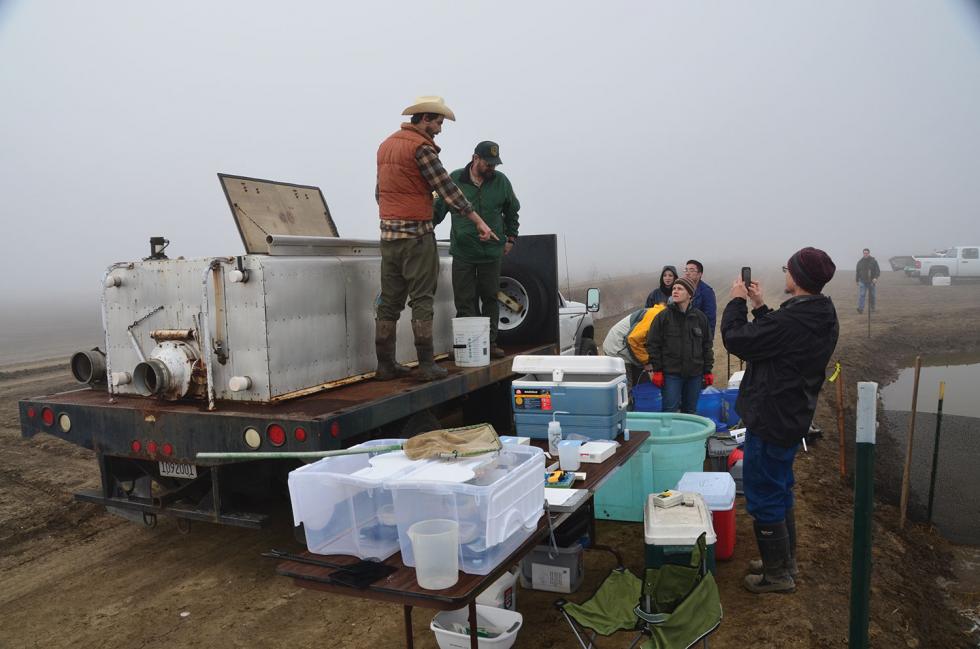
In 2013, Katz and his study team tagged 66 finger-sized salmon with acoustic transmitters. Released into the Sacramento River after spending several weeks on a flooded field, these fish were seven times more likely to be detected by hydrophones anchored under the Golden Gate Bridge than young salmon that had never left the perilous main river channel.
“If you see the size discrepancy between the fish from the river and the fish from [the flooded rice paddy] you immediately see why the fish in the river aren’t making it,” says Jeffres, who collaborated with Katz on the project. “They’re puny.”
Katz believes that if this experiment, called the Nigiri Project, is carried out on a large scale, it could give a substantial boost to naturally spawning salmon populations.
For such restoration work to be most effective, the way fish hatcheries operate must be overhauled. Though it would be expensive, Jeffres says hatcheries should be moved far downstream, perhaps to the western delta or San Pablo Bay. The idea is that the fish, when the time comes for them to make their inland journeys to spawn, would go no further than their birth hatcheries; only salmon born naturally would continue upriver, literally smelling their way home to their birth streams. This means the natural population would face virtually no risk of spawning with genetically inferior hatchery fish. So long as the river fish were provided with cold water at spawning time and safe passage during their seaward migration, a healthy natural population could rebuild.
Floodplanes like the Yolo Bypass could provide salmon with safe downstream travel that bypasses dangerous water pumps in the Sacramento-San Joaquin Delta. The UC Davis Nigiri Project aims to test the impacts of this option.
Another idea that has been discussed by scientists is to make hatchery-born fish identifiable by clipping off each one’s adipose fin, located near the tail, just prior to its release. Several years later, these salmon could be physically barred from entering natural spawning grounds by fish weirs, simple contraptions that funnel migrating fish into a narrow chute. This would allow attendants to capture and kill all salmon missing their adipose fins while allowing the rest (presumably naturally born fish) to pass. Bernie May, a UC Davis biologist who participated in a 2-year hatchery analysis and review several years ago, says hatcheries could even continue to operate under this arrangement.
“But we’d only want naturally born salmon to spawn there,” he says. This system, though cumbersome and laborious, would prevent problems associated with hatchery propagation from magnifying through generations of spawning.
The drought is having dire impacts on the Sacramento’s naturally spawning salmon. Last fall, lethally warm water exiting drought-depleted Lake Shasta killed millions of fertilized salmon eggs in the natural spawning beds near Redding. Given current low levels and high water temperatures in the lake, biologists expect to see similarly high mortality rates this fall.
Floodplanes like the Yolo Bypass could provide salmon with safe
downstream travel that bypasses dangerous water pumps in the
Sacramento-San Joaquin Delta. The UC Davis Nigiri Project aims to
test the impacts of this option.
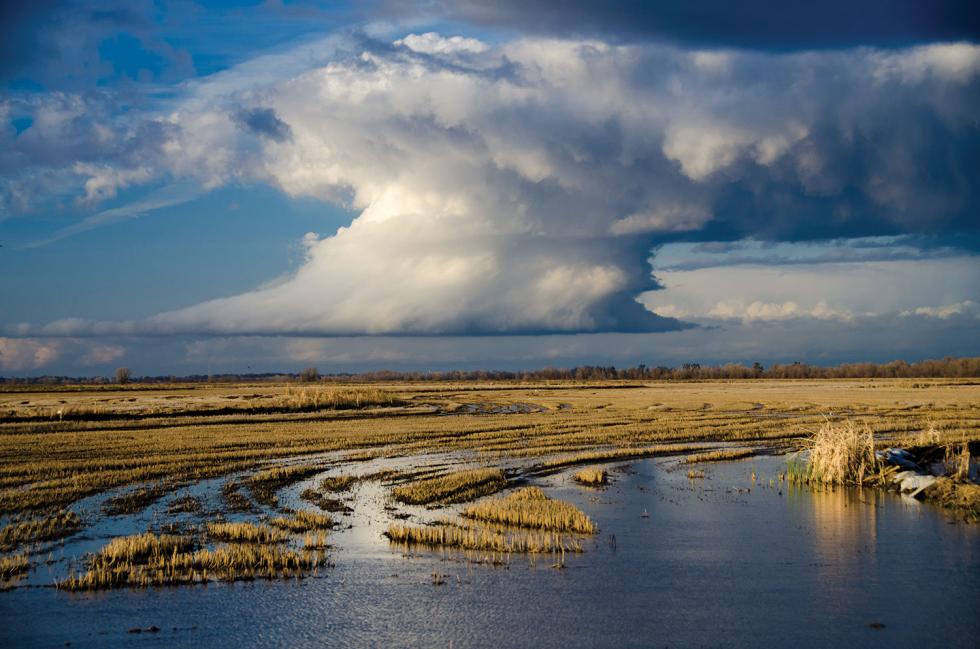
If there is a fishing season off California’s coast two years from now, it will be thanks to hatcheries, which use water cooling systems to protect eggs and young fish. Indeed, even those who would like to see the Central Valley repopulated by thriving runs of wild Chinook that spawn in cold healthy rivers know the hatcheries must continue to operate, at least for now.
“If we shut the state’s salmon hatcheries tomorrow, we’d have almost no salmon,” Jeffres says. “That’s because almost none of the wild fish make it. We have to provide the habitat for the fish, and for now, we need the hatcheries to produce the salmon.”



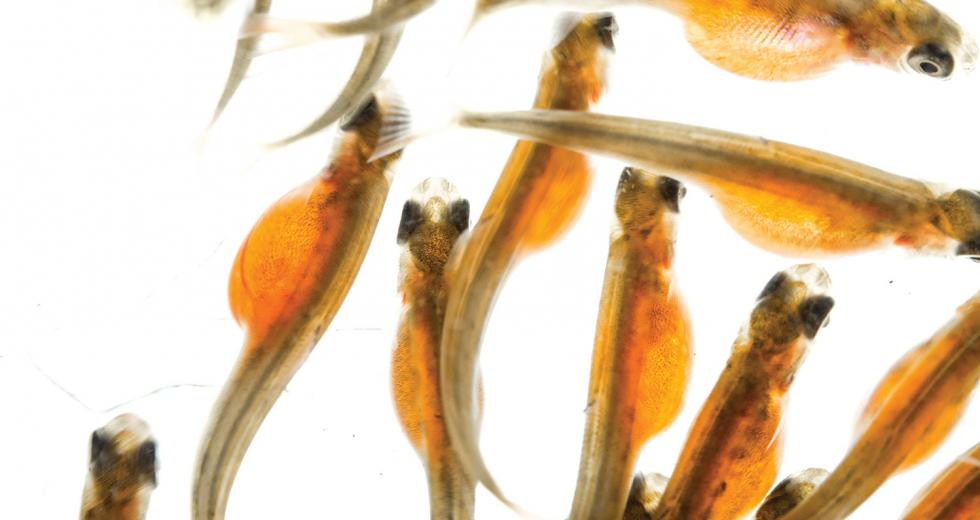
Comments
Great article
It looks like we should be breeding salmon that can reproduce in warmer water. I bet there's a temperature gene somewhere that needs to be jiggled a little bit.
Stop screwing with the fish! Give them back the habitat and water they need to thrive, and stop catching and killing them. Let them live, and let the animals who genuinely depend on them: the starving sea lions, orcas, sea birds, etc., have enough of them to survive. All of the nutrients we need to thrive can be obtained more humanely, healthfully, and environmentally responsibly from plant sources.